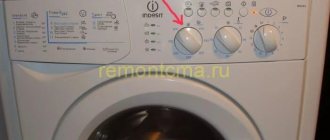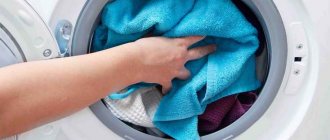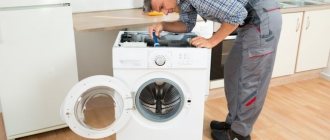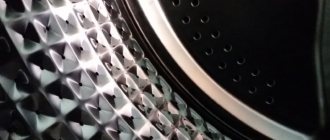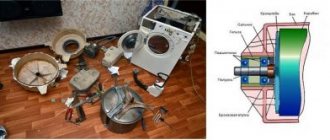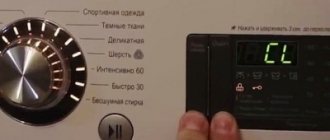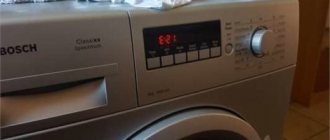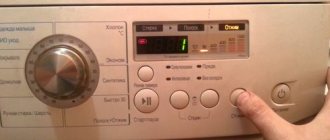The washing process seems to be proceeding, but the spin mode does not work. What to do: call a specialist, take the washing machine to a service center or buy a new one? It can be especially unpleasant if the cause of a “global” breakdown is clogged and worn brushes, which can be repaired yourself. If the washing machine does not spin out water, then you need to find out the reasons for the breakdown and further repairs, first check the operation of the program, and see if the spin function is disabled. It is necessary to exclude failure of several system components and other problems:
Drain malfunction
If the spin in the machine does not work for this reason, then you need to remove the hose from the sewer drain and place it at a lower level. Ideally - right on the floor. In fact, it will be enough to lower most of the hose (tube) lower than the washing machine tank so that the water begins to actively drain. The problem occurs in 2 cases:
- if the design has a bend in a flexible drain tube that works like a siphon;
- if the short drain tube or hose is dirty.
Picture 1
Draining water from a hose
The machine should drain the water. If this is not the case, then the spin mode does not work due to a malfunction of the hose and other elements:
- Filter. If the washing machine does not spin clothes and there is no drain, then there is a possibility of a blockage. In this case, water must be removed through the holes located before the drain pipe. All modern models have a filter that protects the drain pump from objects: paper clips, lumps of thread, small coins. Usually the filter is located on the front of the washing machine at the bottom. You can get to it through a round hatch by detaching the decorative panel that hides the base of the case.
Figure 2
You need to tilt the washing machine on its side, unscrew the filter and place it in a horizontal plane again. A water container is installed under the drain filter hole. This method is easy and effective. Removes water almost completely. There is a negative point - some of the water may spill on the floor.
- Emergency drain hose. Most washing machine models are equipped with a special flexible tube for emergency drainage, which is connected directly to the tank, bypassing the drain pipe and filter element. Some models have an emergency hose attached to the drain system after the filter. It may not turn on if the filter or pipe is dirty. In practice, removing water through the emergency tube takes a long time due to its small diameter. Typically, the emergency hose is located next to the filter (if there is a hatch) or on the other side under the removable panel. To drain the water using it, you will need to pull out the plug and direct the hose into the vessel.
Figure 3
Draining water through an emergency hose
Wrong program selected
Usually the spin mode in the washing machine does not work due to incorrectly configured software. There may be a problem with the washing program that was installed: the water does not pour out after the wash is completed, and the machine waits for the required command to drain the liquid and spin the clothes.
Figure 4
When the spin cancel button is pressed, it is depicted in the form of a spiral - crossed out with a line diagonally. If this button is pressed, the wash will not spin. Disable it to allow the process to resume.
The speed control is set to 0 - this is the reason why the washing machine does not spin the clothes, but drains the water.
Bad spin
If the laundry is not wrung out well enough, it is recommended to seek qualified help. There are a number of standard reasons that service engineers eliminate.
- Clogged pipes and clogged filter. When dirt accumulates, water cannot be drained in the quantities provided for by the characteristics of the machine. It needs to be disassembled, cleaned or filters changed.
- The engine is faulty. In case of interturn short circuits and other non-critical failures, it continues to work. However, in spin mode, the motor cannot accelerate the drum to optimal speed. As a result, the laundry remains damp.
There are also problems in the control system. They are diagnosed quite simply. The machine freezes, does not start spinning, and cannot correctly execute the specified program.
The pump is faulty or clogged
Figure 5
The most common problem is a clogged pump. When you remove the filter of the device, you can see the cross-shaped pump blades inside. You need to scroll them with your finger. If they don't spin, then something is stuck. Therefore, you should inspect the pump and remove the blockage inside.
If spinning occurs, but the water does not go down the drain, then the clothes remain wet after twisting. To repair, you need to change the pump. How to replace the pump in different models of washing machines:
- Turn off equipment from power sources, water supply, drainage.
- Mount the housing in a side position.
- Detach the bottom to gain access to the pump.
- Unscrew the screws and disconnect the pump by pressing on the side of the drain valve.
- Disconnect the wires from the pump.
- Remove the clamps and pour some of the water into the prepared vessel.
After this, you need to disassemble the pump, remove and clean the volute (if it is suitable for use) and change the pump. At the end, collect all the elements.
No spin
If you have to take completely wet laundry out of the machine, this does not always mean that it’s time to get upset and prepare for the costs of repairing the washing machine. Modern models are equipped with many automatic protection systems. Therefore, the case when the spin does not work may not be caused by physical breakdowns of the mechanics or electronics. This is often due to user errors or obvious violations of the device operating rules.
- The housewife loads an excessive amount of laundry into the machine. The loading volume of the model is always indicated in the instructions for its use. And if you load more into the drum, it will simply stop. This is standard protection that is present in modern models and prevents engine overload.
- An error was made when selecting the washing mode. For example, many washing machines have the option of so-called delicate processing of laundry or hand washing. In these cases, spinning is not provided or is performed at very low speeds. As a result, wet laundry has to be removed from the drum. There is only one piece of advice: you need to choose the right washing mode before starting the machine.
- If the washing machine is controlled by mechanical buttons, the lack of spinning may be due to the accidental pressing of the corresponding switch, which turns it off. The same situation occurs when the contact groups of the control panel are excessively dirty.
- There are too few things in the drum. In this case, the sensors of modern models detect imbalance during rotation, and the machine stops spinning. This prevents damage to the mechanical parts of the drive and drum.
Rarely, a non-working spin cycle is associated with a broken pump. In this case, the machine runs the cycle normally. But due to the lack of water pumping, the laundry remains wet. However, this situation is very rare. Modern machines detect a pump malfunction, display errors or refuse to start the wash cycle.
Laundry is not distributed correctly
A common reason why a washing machine does not spin. Modern machines recognize that objects are unevenly placed inside the drum and do not turn on the spin program until they have resolved the problem, or they stop the wash and indicate an error code on the screen.
To avoid this situation, you need to cancel the spin cycle when washing clothes, especially duvet covers. At the end of washing, rinsing and stopping, you need to take out the laundry and straighten it, and then throw it back into the drum and set the spin program.
Some machine models have a built-in function for analyzing the condition of the laundry: if the device has detected that the items do not meet the requirements, then you need to check the “No spin” button. It is possible that the no-twist function was enabled accidentally.
Preventive measures
By following the basic rules and operating recommendations, you can partially avoid damage to your washing machine.
- Periodically rinse the dispenser to remove any residual detergent.
- Do not overload the machine with laundry.
- Before washing, check all pockets and remove small parts that may clog the filter.
- Pour detergent strictly according to the norm; excess may accumulate in the dispenser and clog the grate.
- After each wash, wipe the rubber cuff of the hatch with a dry cloth.
- Maintain intervals between washes of 1-2 hours.
If you notice malfunctions and find a malfunction, immediately fix it. Remember: operating such a unit is prohibited and dangerous to life.
Technical generator breakdown
A rare reason why the spin cycle does not work. Device malfunction occurs when the drum is frequently overloaded. If the loading rate specified by the manufacturer is regularly violated, this element may stop working in a short time. The tachogenerator is mounted on the shaft of the power unit and is designed to control speed during the washing process. If the sensor breaks, then the washing machine does not spin out the laundry; the rotation speed is not enough to perform this action.
Another reason for the malfunction of the tachogenerator is loosening of the contacts and wires leading to this element. To diagnose the problem, you need to check the fasteners and tighten them tighter.
Figure 6
If the wiring or adjacent contacts are damaged, they must be cleaned and taped. If the tachogenerator itself malfunctions, the part must be repaired or replaced.
Prevention measures
Simple rules will help keep your washing machine operating and prevent breakdowns:
- inspect the laundry before washing. Clothes decorated with small details should be washed in special bags;
- do not overload the equipment. Constantly loading laundry with a total weight exceeding the permissible limit will result in motor failure;
- Use the recommended amount of powder; it is better to choose liquid detergents. Failure to comply with the rule will lead to breakdown of the pressure switch;
- Use surge protection. Constant vibrations can damage the most expensive part - the control board.
Engine repair
The washing machine does not spin clothes due to a breakdown of the power unit? If the machine is equipped with a conventional belt motor rather than an inverter motor, the brushes will gradually wear out, causing a problem. If the motor is not running properly, the drum cannot reach the speed required for the final washing phase.
You can solve the problem yourself if you have mechanical knowledge: you need to remove the back wall of the case, then the strap from the electric motor and disconnect the wires, and then unscrew the electric motor itself from the drum. During diagnostics, faulty engine parts can be identified and replaced with new ones.
How to determine a power unit failure:
- if the engine sparks during the test, then the brushes need to be replaced;
- in case of strong noise and overheating of the equipment, the cause may be a violation of the integrity of the winding;
- peeling of the lamellas and the appearance of burrs on them entails the occurrence of sparks.
The lamellas should be checked during disassembly at the same time as the graphite brushes.
Figure 7. Engine.
Damages need to be eliminated as follows:
- Turn off the machine - disconnect drains, water pipes and electronic networks.
- Disassemble the product body: remove the panel and straps.
- Unscrew the bolts securing the engine.
- Disconnect terminals and wires connected to other elements.
- If the tank prevents access to the engine, you need to lift it.
- Different models have an individual device, so you need to remove the walls on the sides of the unit to properly remove the motor.
After this, you need to lift the broken elements or tighten their fastenings for normal operation.
Faulty motor brushes
Signs of breakdown: the machine sparks and does not gain speed during the spin cycle, and the parts themselves are worn out and come into weak contact with the collector. Because of this, the power unit does not create enough torque to rotate the drum during the spin cycle.
The washing machine does not spin: what to do or how to replace and change the brushes:
- Disconnect from the network.
- Close the water inlet valve.
- Drain some of the water from the tank by unscrewing the inlet pipe. Attention! Water may suddenly start flowing.
- Remove the lower front part by removing the drain filter and draining some of the water using an emergency hose.
- Position the machine so that it is convenient to work with it.
- After this, you need to remove the engine by removing the back cover - it is secured with screws.
- Remove the drive belt. To do this, pull it slightly towards you and turn the pulley counterclockwise.
- Take a photo of the location and connection of the wires and disconnect them.
- Inspect the motor without dismantling.
After that, proceed to replacement:
- Unscrew the brush holder bolts and remove;
- carefully select the carbon rods;
- remove the brush from the socket;
- install a new product;
- repeat the procedure for another carbon contact.
Figure 8.
Motor brushes
If the unit is equipped with a direct drive, then the sequence of actions is different:
- Remove the rear cover.
- Remove the rotor. This is required to access the brush holders.
- Replacement brush is similar. You need to watch the direction of sharpening.
Before installing new parts, you need to wipe the collector with a cotton swab to clean it of carbon deposits and dust.
How to clean the drain filter
I would like to say a few words about this, because your actions will depend on the specific model of the washing machine:
- In Indesit, the hatch is made of fragile plastic material, and it must be opened quite carefully;
- Samsung is distinguished by the presence of special latches that open with a simple screwdriver;
- The hatch in Lg will not give in to you easily - you must press the button intended for this;
- Ardo also has access to the filter element from the front, but from the front side of the housing.
Unscrewing each filter is done the same way, only on certain models there are screws in the form of clamps. It is recommended that you carefully inspect the cap before you try to unscrew it.
Having organized access to the filtering device, it must be thoroughly cleaned and installed in its place. After this, it is recommended to test the washer. It is quite possible that this was not the only problem.
Checking the control module
This component is responsible for all machine system programs, in particular spin execution.
Figure 9.
Control module
The spin function cannot be started due to a module malfunction. You won’t be able to check the control unit at home, so you will need the help of a specialist.
If the control unit malfunctions, the technician diagnoses the board, replaces the broken parts with new ones, and then solders the tracks and contacts.
Damage to shock absorbers and bearings
These products are used to dampen vibrations in the washing machine during washing and spinning. When they wear out, the device vibrates strongly, and the electronics do not spin the drum, and the spin mode in the washing machine does not work. It is also possible for the drum to knock on the body part.
If the bearings break, the seal gradually loses its tightness, liquid gets inside the products and washes out the lubricant. The bearings begin to rust and are destroyed by vibration. When the drum is shaken by hand, it dangles on the shaft. There may also be leaks on the outside of the tank. Bearings need to be replaced.
Broken pressure switch
Signs of a faulty water level switch, as this part is also called, are problems with diagnostics, lack of liquid when starting the wash, and exceeding the normal water level. The problem leads to the start of the heating element, a malfunction of the heating device. The result is poorly wrung out laundry and water in the tank.
The problem is solved by reconfiguring the level relay. A specialist who understands washing machines of a certain brand has the right to do the work. If the issue cannot be resolved this way, then the pressure switch needs to be replaced with a new one.
Video
From the following video you will learn how to restore the spin cycle if one of the above problems occurs.
She graduated from the Institute of Tourism of the Federal Pedagogical University with a degree in Management, loves to travel and communicate with people. She is interested in psychology, enjoys dancing, and studies English. During the five years of maternity leave, I thoroughly mastered housekeeping, not forgetting about my own development. He skillfully uses words and can support a conversation on any topic thanks to his interest in different areas of life.
Found a mistake? Select it and click the buttons:
The first officially patented washing machine was made of wood and was a box with a frame, half filled with wooden balls. Laundry for washing and detergent were loaded inside and the frame was moved using a lever, which, in turn, made the balls move and grind the laundry.
History knows the fact that a kitten fell into the drum of a washing machine and, after going through a full wash cycle on the “Wool” program, got out of the unit unharmed. The only trouble for the pet was an allergy to washing powder.
Washing machines have something to do with the origin of the expression “money laundering.” In the 1930s, American gangsters used a network of laundries as a cover for their illegal activities. By passing off the proceeds of crime as proceeds from cleaning clothes, they turned “dirty” money into “clean” money.
Astronauts, while in Earth orbit, solve the problem of dirty things using an original method. Clothes are dropped from the spacecraft and burn up in the upper atmosphere.
There are a variety of balls that are used in the washing machine. Antistatic ones will prevent the fabric from sticking to the body after washing, balls with special loops will “comb” the lint and prevent the appearance of pills, and silicone ones with pimples will prevent fluff from matting when washing outerwear.
Washing machines equipped with the “No Iron” or “Easy Iron” functions can wash clothes with little to no wrinkling. This effect is achieved through a special approach to spinning - it is performed at low speeds, with long pauses, and a small amount of water is retained in the tank.
There is a washing machine “for bachelors”. Linen washed in such a unit does not need to be ironed at all! The thing is that the device does not have a drum: some things can be placed inside the container directly on hangers (for example, jackets and shirts), and smaller things (for example, underwear and socks) can be placed on special shelves.
For washing small items on the road or in a hotel, it is convenient to use a regular plastic bag. Socks or tights are kneaded inside a tied bag along with water and a small amount of detergent. This method allows you to pre-soak things and wash them without damaging the fabric or wasting a lot of powder and water.
Failure of the heating element
The heater wires are located close to the body part. Electrical wiring frays due to strong vibrations that are created during operation. The problem is solved by soldering the damaged sections or replacing the wires.
Figure 10.
If the heating element does not function due to scale, then you need to use a softener. This element may not work if the heating sensors and liquid level detection are faulty. In this case, instead of the heating element, you only need to replace the broken elements.
Let's sum it up
The article provided instructions on what to do if the washing machine does not spin clothes. All actions are conditionally divided into categories:
- Removing liquid from the tank.
- Finding out the reasons for the breakdown.
- Trying to fix it yourself.
The last point is the most important. If you can reconfigure the program or remove the clogged drain tube yourself, in which case incorrect actions will not cause harm, then replacing damaged parts is the responsibility of a specialist. If you suspect that the cause of the breakdown is in the control module, then it is better to take the device to a service center yourself. Only a professional workshop has equipment to diagnose it.



